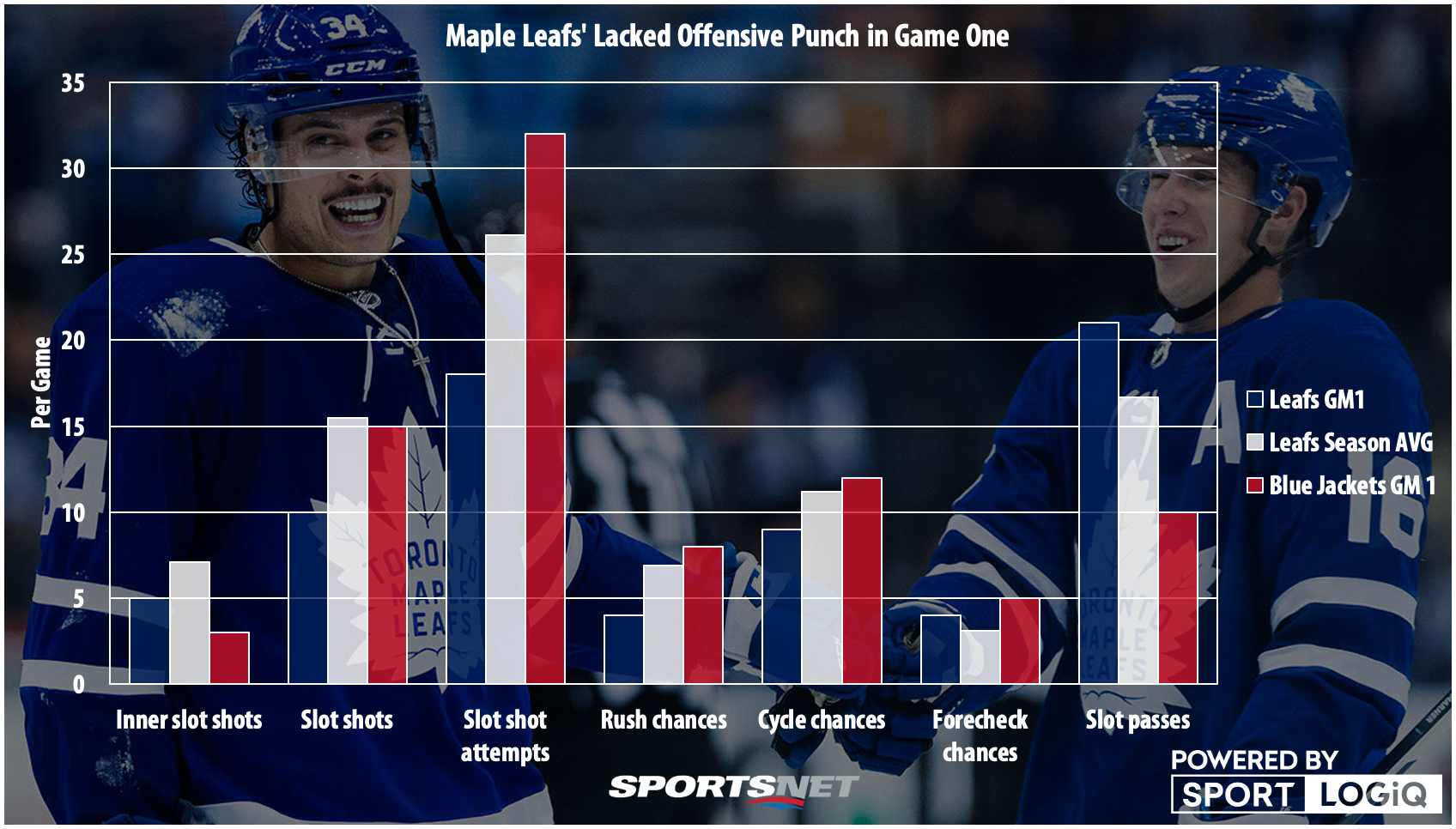Hockey is back, and the play-in round is rattling off games all day, every day. It can be difficult to keep up, so during these playoffs we’re going to attempt a bit of an analytical round up of interesting trends and how they may impact certain matchups.
WHY COLUMBUS WON GAME 1
Speaking of certain matchups, I recently wrote about how differently the Blue Jackets play with Seth Jones in the lineup, and why those changes could spell significant trouble for the Maple Leafs, so how did things play out in Game 1?
The Blue Jackets were able to create lots of offence off the forecheck, tying the highest mark of any team in a single game in this short post-season with five chances. But the Maple Leafs were able to counter with strong forechecking of their own and rattled off four of them. Forechecking wasn’t the difference in Game 1, defence was.

The Blue Jackets held the Maple Leafs to 18 shot attempts from the slot in all situations, a far cry from their regular season average of 26.1. The Blue Jackets smothered the Leafs’ offence and forced them into a game along the boards. The Leafs were still able to use their elite playmaking to connect on a ridiculous number of slot passes in Columbus’ zone, but they couldn’t convert them into shots because they were being checked so closely.
In fact, while the Blue Jackets were able to generate eight scoring chances on net with no Maple Leafs player pressuring the shooter within six feet, the Leafs created just a single shot in that setting — the Auston Matthews one-timer the broadcast pointed out when highlighting him leaving the offensive zone to shake checks and find open spots on the ice.
That shot by Matthews was a superb chance and most times it would end up in the back of the net, but it was the only truly excellent chance the Leafs were able to put on net all night. They’re going to have to find a way to play their own game more to win this series.
One good sign for the Leafs is that for all the pressure the Blue Jackets created, they didn’t beat Frederik Andersen once from the slot. The one goal they did score he likely should have had — a hard shot from just outside the slot — and his one mistake ended up overshadowing a very strong showing.
FLAMES’ BIG EDGE IN GAME 1 WAS ABSENT IN GAME 2
The injury to Mark Scheifele casts a dark cloud on this series right away, and the fact is without him the Jets don’t have a lot of depth at centre. Scheifele is the lynchpin of the Jets’ offence, and without him in the lineup they’re in deep trouble if the Flames keep playing the solid defence we saw in Game 1.
You could be forgiven for seeing that the shot attempt count was 56-50 in Calgary’s favour and think Game 1 was closer than it looked. Heck, you could see that the scoring chances were just 21-19 for Calgary, so the Jets seemed to be very much right there with them.
Except when you look at slot shots that actually hit the net, the Flames dominated 15-5 in all situations, making it one of the Jets’ worst offensive performances of the season.
The initial burst of emotion that resulted in Andrew Copp’s goal was followed up by two good chances by Patrik Laine and Nikolaj Ehlers, but their next scoring chance on net came nearly 17 minutes later off the stick of Matthieu Perreault — and that was the last shot from the slot the Jets recorded.
The Jets evened the series up in Game 2 by coming close to evening up the slot shots on net, which were still 12-11 in favour of Calgary. That allowed Connor Hellebuyck to be a difference maker, and in a big change from Game 1, the Jets dominated the inner slot with five shots on net to Calgary’s one.
Keeping things just even could be enough to swing things in Winnipeg’s favour.
PENGUINS RUSHED SHOTS IN GAME 1
Not to take anything away from Carey Price, who was excellent all through Game 1 and likely decided the fate in the first period when he stopped the surging Penguins from striking, but Pittsburgh looked like a team that was too desperate to score first.
In Game 1, the Penguins totalled 40 shot attempts from the slot, and 105 shot attempts overall — both high marks for any team in the playoffs so far. Relentless pressure by the Penguins had the Canadiens running around and taking bad penalties, but they didn’t take advantage of the space created, missing the net on 15 of their 40 shot attempts from the slot, and recording 33 misses overall.
Full credit to the Canadiens for blocking nine Penguins shot attempts from the slot in Game 1, and 29 shots overall, but only the Jets had fewer of their attempted shots make it through to the net than the Penguins did.
In Game 2, the Penguins got out of their own heads a bit and played what looked like a less dominant offensive game on the surface. The only managed 28 total shot attempts from the slot, but instead of missing on 15 of those shots and seeing another nine blocked, they only missed five times and put 20 on net.
The result was relatively similar with Price somehow being even stronger in Game 2, but the Canadiens didn’t manage to get the luck in their own infrequent shooting this time around, and the Penguins tied the series.
[relatedlinks]








